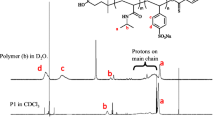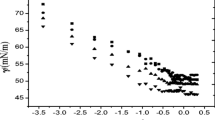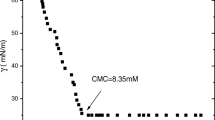Abstract
Zwitterionic amphiphilic diblock copolymers having n-butylacrylate(n-BA) and carboxybetaine as hydrophobic and hydrophilic blocks, respectively, with various chain lengths were synthesized by the reversible addition-fragmentation chain transfer (RAFT) polymerization method. The effects of salt and chain length on the solution behaviour of zwitterionic amphiphilic diblock copolymers were investigated using surface tension, static light scattering (SLS), dynamic light scattering (DLS) and fluorescence spectroscopic measurements. Surface tension measurements revealed that zwitterionic amphiphilic diblock copolymers undergo transition from surface active to non-surface active after addition of salt. This may be due to the transition from zwitterionic (almost zero charge) to ionic nature of the betaine block by addition of small amount of salt followed by an increase of solvent power of salt solution. Foam formation behaviour decreased with increasing chain length. The critical micelle concentration was decreased drastically by the presence of a small amount of salt, which reflected the non-surface active nature of block copolymer. Increase in values of hydrodynamic radii with increase in salt is attributed to stretching of the hydrophilic chain due to the ionic nature of the block chain and the increase of solvent power. Aggregation number (N agg ) and the second virial coefficient (A 2) decreased with the increase in chain length as well as after addition of salt. Packing parameters of block copolymer micelles were less than 0.3 which implies that the micellar shape is spherical. Some unique aspects of zwitterionic polymer were elucidated, which are largely different from simple ionic (anionic and cationic) polymers.










Similar content being viewed by others
References
Marques CM, Joanny JF, Leibler L (1988) Adsorption of block copolymers in selective solvents. Macromolecules 21(22):9938–9945
Marques CM, Joanny JF (1989) Block copolymer adsorption in a nonselective solvent. Macromolecules 22(3):1454–1458
Wittmer J, Joanny JF (1993) Charged diblock copolymers at interfaces. Macromolecules 26(11):2691–2697
Netz RR, Andelman D (2003) Neutral and charged polymers at interfaces. Phys Rep 380(1):1–95
Matsuoka H, Matsutani M, Mouri E, Matsumoto K (2003) Polymer micelle formation without Gibbs monolayer formation—synthesis and characteristics of amphiphilic diblock copolymer having sulfonic acid groups. Macromolecules 36(14):5321–5330
Matsumoto K, Ishizuka T, Harada T, Matsuoka H (2004) Association behavior of fluorine-containing and non-fluorine-containing methacrylate-based amphiphilic diblock copolymer in aqueous media. Langmuir 20(17):7270–7282
Matsuoka H, Maeda S, Kaewsaiha P, Matsumoto K (2004) Micellization of non-surface-active diblock copolymers in water. Special characteristics of poly(styrene)-block-poly(styrenesulfonate). Langmuir 20(18):7412–7421
Kaewsaiha P, Kozo M, Matsuoka H (2005) Non-surface activity and micellization of ionic amphiphilic diblock copolymers in water. Hydrophobic chain length dependence and salt effect on surface activity and the critical micelle concentration. Langmuir 21(22):9938–9945
Kaewsaiha P, Matsumoto K, Matsuoka H (2007) Sphere-to-rod transition of non-surface-active amphiphilic diblock copolymer micelles: a small-angle neutron scattering study. Langmuir 23(18):9162–9169
Nayak RR, Yamada T, Matsuoka H (2011) Non-surface activity of cationic amphiphilic diblock copolymers. IOP Conf Ser Mater Sci Eng 24:012024
Ghosh A, Yusa S, Matsuoka H, Saruwatari Y (2011) Non-surface activity and micellization behavior of cationic amphiphilic block copolymer synthesized by reversible addition fragmentation chain transfer process. Langmuir 27(15):9237–9244
Matsuoka H, Fujita S, Ghosh A, Nakayama S, Yamakawa Y, Yusa S and Saruwatari Y. (2013) Nanostructure of cationic polymer brush at the air/water interface. MATEC Web of Conferences (EDP Sciences publisher), 4, 04001p1-p4, DOI:10.1051.mateconf.201304001
Shrivastava S, Matsuoka H (2014) Photo-responsive block copolymer: synthesis, characterization and surface activity control. Langmuir 30(14):3957–3966
Ghosh A, Yusa S, Matsuoka H, Saruwatari Y (2013) Effect of chain length and salt on the temperature-responsive cationic amphiphilic diblock copolymer. J Chem Biol Interfaces 1(1):41–48
Ghosh A, Yusa S, Matsuoka H, Saruwatari Y (2014) Chain length dependence of non-surface activity and micellization behavior of cationic amphiphilic diblock copolymers. Langmuir 30(12):3319–3328
Amiel C, Sikka M, Schneider JW, Tsao YH, Tirrell M, Mays JW (1995) Adsorption of hydrophilic-hydrophobic block copolymers on silica from aqueous solutions. Macromolecules 28(9):3125–3134
An SW, Su TJ, Thomas RK, Baines FL, Billingham NC, Armes SP, Penfold J (1998) Neutron reflectivity of an adsorbed water-soluble block copolymer: a surface transition to micelle-like aggregates at the air/water interface. J Phys Chem B 102(2):387–393
An SW, Su TJ, Thomas RK, Baines FL, Billingham NC, Armes SP, Penfold J (1998) Neutron reflectivity of adsorbed water-soluble block copolymers at the air/water interface: the effects of composition and molecular weight. Macromolecules 31(22):7877–7885
Eghbali E, Colombani O, Drechsler M, Muller AHE, Hoffmann H (2006) Rheology and phase behavior of poly(n-butyl acrylate)-block-poly(acrylic acid) in aqueous solution. Langmuir 22(10):4766–4776
Garnier S, Laschewsky A (2006) New amphiphilic diblock copolymers: surfactant properties and solubilization in their micelles. Langmuir 22(9):4044–4053
Onsager L, Samaras NNT (1934) The surface tension of Debye-Hückel electrolytes. J Chem Phys 2:528
Tuzar Z, Pospisil H, Plestil J, Lowe AB, Baines FL, Billingham NC, Armes SP (1997) Micelles of hydrophilic−hydrophobic poly(sulfobetaine)-based block copolymers. Macromolecules 30(8):2509–2512
Lowe AB, Billingham NC, Armes SP (1999) Synthesis and properties of low-polydispersity poly(sulfopropylbetaine)s and their block copolymers. Macromolecules 32(7):2141–2148
Stenzel MH, Kowollik CB, Davis TP, Dalton HM (2004) Amphiphilic block copolymers based on poly(2-acryloyloxyethyl phosphorylcholine) prepared via raft polymerisation as biocompatible nanocontainers. Macromol Biosci 4(4):445–453
Yusa S, Fukuda K, Yamamoto T, Ishihara K, Morishima Y (2005) Synthesis of well-defined amphiphilic block copolymers having phospholipid polymer sequences as a novel biocompatible polymer micelle reagent. Biomacromolecules 6(2):663–670
Mitsukami Y, Donovan MS, Lowe AB, McCormick CL (2001) Water-soluble polymers. 81. Direct synthesis of hydrophilic styrenic-based homopolymers and block copolymers in aqueous solution via raft. Macromolecules 34(7):2248–2256
Oae S, Yagihara T, Okabe T (1972) Reduction of semipolar sulphur linkages with carbodithioic acids and addition of carbodithioic acids to olefins. Tetrahedron 28(12):3203–3216
Berne B, Pecora R (1976) Dynamic light scattering. John Wiley, New York, p 174
Zimm BH (1948) Apparatus and methods for measurement and interpretation of the angular variation of light scattering; Preliminary results on polystyrene solutions. J Chem Phys 16(12):1099–1116
Kerker M (1969) The scattering of light and other electromagnetic radiation. Academic Press, New York. pp, 434
Inayama R, Nakamura S, Tatsumi N, Private communication.
Jiang W, Fischer G, Girmay Y, Irgum K (2006) Zwitterionic stationary phase with covalently bonded phosphorylcholine type polymer grafts and its applicability to separation of peptides in the hydrophilic interaction liquid chromatography mode. J Chromatogr, A 1127:82–91
Katagiri K, Hashizume M, Kikuchi J-i, Taketani Y, Murakami M (2004) Creation of asymmetric bilayer membrane on monodispersed colloidal silica particles. Colloids Surf, B 38:149–153
Parker AP, Reynolds PA, Lewis AL, Kirkwood L, Hughes LG (2005) Investigation into potential mechanisms promoting biocompatibility of polymeric biomaterials containing the phosphorylcholine moiety: a physicochemical and biological study. Colloids Surf, B 46:204–217
Corrin ML, Harkins WD (1947) The effect of salts on the critical concentration for the formation of micelles in colloidal electrolytes. J Am Chem Soc 69(3):683–688
Selb J, Gallot Y (1980) In polymeric amines and ammonium salts. In: Goethals EJ (ed) Pergamon Press, New York, pp 205-218.
Xu R, Winnik MA, Hallett FR, Riess G, Croucher MD (1991) Light-scattering study of the association behavior of styrene-ethylene oxide block copolymers in aqueous solution. Macromolecules 24(1):87–93
Khougaz K, Astafieva I, Eisenberg A (1995) Micellization in block polyelectrolyte solutions. 3. Static light scattering characterization. Macromolecules 28(21):7135–7147
Israelachvili JN (1991) Intermolecular and surface forces, 2nd edn. Academic Press, London/New York
Nagarajan R (2002) Molecular packing parameter and surfactant self-assembly: the neglected role of the surfactant tail. Langmuir 18(1):31–38
Acknowledgment
M. Sivanantham gratefully acknowledges the Global Centre of Excellence (GCOE), GCOE for International Center for Integrated Research and Advanced Education in Material Science, for providing post-doctoral fellowship. We thank Dr. Yoshiyuki Saruwatari (Osaka Organic Chemical Industry) for kind donation of carboxybetaine monomer. This work was supported by a grant-in-aid for the Scientific Research on Innovative Areas “Molecular Soft-Interface Science” (20106006) from the Ministry of Education, Culture, Sports, Science and Technology of Japan, to which our sincere gratitude is due.
Author information
Authors and Affiliations
Corresponding author
Rights and permissions
About this article
Cite this article
Murugaboopathy, S., Matsuoka, H. Salt-dependent surface activity and micellization behaviour of zwitterionic amphiphilic diblock copolymers having carboxybetaine. Colloid Polym Sci 293, 1317–1328 (2015). https://doi.org/10.1007/s00396-015-3503-1
Received:
Revised:
Accepted:
Published:
Issue Date:
DOI: https://doi.org/10.1007/s00396-015-3503-1




